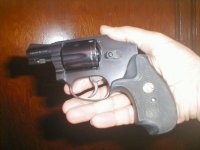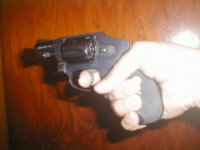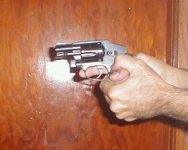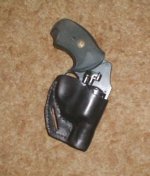Regarding the Miculek grip:
I've used it ever since seeing it and it's without question the best technique available for controlling small revolvers and auto pistols. Yes, I said auto pistols as well. There simply isn't much real-estate on these smaller handguns that would allow you to effectively use the standard grip. Further, for a lot of folks a traditional thumbs-forward grip places their weak thumb perilously close to the gap between the cylinder and forcing cone. This can be cured, of course, by installing larger grips but that has a price in terms of concealment and leaves out the two best laser options for the J frame. (I consider a laser to be required equipment for a J frame because of the enormous boost to performance the laser offers in low light)
A key part of the technique is locking the left thumb somewhere under the first joint of the right thumb, using that as a reference point. This allows the use of that grip without worry about getting the left thumb in the way of the slide. If more room is desired you can angle the left thumb all the way down to touching the wrist and still get the same benefit. In the picture on the previous page, Jerry's left thumb is very high...which you can do with a J frame revolver and the enormous grip strength a professional shooter brings to the table. Modifying the thumb placement impacts the effectiveness a bit, but only a little bit in my experience.
The second key is to grip very hard with the left hand...think of your left hand as a hydraulic press with the goal of crushing the grip. This helps resist the torque applied to the trigger (12-15 pound trigger, 1.x pound handgun...the math isn't in your favor) which improves the ability to keep the sights aligned. It also helps manage recoil better than any other technique I've ever tried, seen, or heard of. Obviously the more grip strength you have the more effective the grip is, but I've taught it successfully to even small females. When used in conjunction with other fundamentals of controlling a handgun (chin forward of the belt line, use of the pectorals, etc) it allows even small females with relatively little grip strength to manage guns like the J frame or the LCP effectively. That means they tend to shoot more since they no longer get punished by the recoil...which is always a good thing.
The grip does take a bit of time to learn/teach and does require some practice, but the benefits it offers in terms of control and accuracy are more than worth it. As for using it under stress, just as with any other skill if you train properly you'll probably be able to use it under stress. I have absolutely no problem switching between a standard grip on a semi-automatic pistol I carry every day and the Miculek grip (although I'm sure he didn't invent it) on the 442 I carry as a BUG every day.
When properly understood, properly trained, and properly put into practice it's a very effective technique...vastly moreso than anything else available. For those motivated enough to seek out training or to seek to improve their skill with a weapon like the J frame it's a good option. It would not be a good technique for the poorly motivated who are largely a danger to themselves. In other words, it isn't a technique I would teach to the sort of person who wouldn't be willing to spend an hour or two doing dryfire runs of learning to acquire the grip properly so they don't injure themselves.
 '
'




